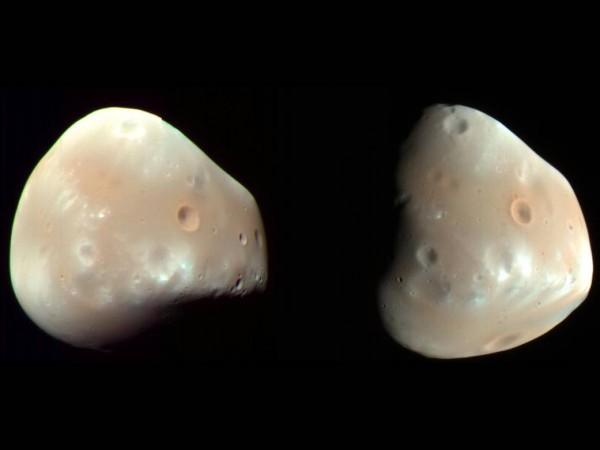
NASA has released a footage of Mars' moons Phobos and Deimos 'dancing', and as it turns out, they are nothing like our notion of how moons look. From lumpy to misshapen, these moons have very little in common with the round moon of Earth – as the space agency described in a press release.
And not just that, these moons are also some of the smallest moons in the entire solar system!
Phobos is just 14 miles wide and Deimos happens to be even smaller at a width of just 8 miles, making the Earth's moon over a hundred times their size as it is a vast 2,159 miles wide. The moons' orbit around their planet is also much closer than that of Earth's. Phobos is at a distance of 3,700 miles above Mars' surface – which allows it flies around the planet thrice a day.
They also recorded that at the time Phobos was observed, it was about 3,489 miles from Mars Odyssey, while Deimos' distance at the time of observation was around 12,222 miles. In the 19 images taken by the THERMIS camera, the human eye is able to notice the images only because of the visible-wavelength light that was used in the process.
NASA’s Mars Odyssey orbiter catches both moons of Mars, Phobos and Deimos, in one sequence. https://t.co/sOg5Ki2KFo pic.twitter.com/2i7jwlbDNI
— NASA Solar System (@NASASolarSystem) February 23, 2018
The THERMIS camera was developed and is operated by the Arizona State University, and its name happens to be an acronym for Thermal Emission Imaging System, and it is also a feature of the orbiter Mars Odyssey.
The Mars Odyssey spacecraft has been orbiting the planet since 2002 and this was its second time observing Phobos – the first time being back on September 29, 2017. In the captured footage released, the moons appear to dance away from each other and NASA explained the phenomenon with an official statement.
"The apparent motion is due to progression of the camera's pointing during the 17-second span of the February 15, 2018, observation, not from motion of the two moons," the space agency explained.
"Researchers have been using THERMIS to examine Mars since early 2002, but the maneuver turning the orbiter around to point the camera at Phobos was developed only recently," the statement read, implying that there's further scope for more such magical images of space in the future.
The Mars Odyssey orbiter had also successfully managed to capture its first images of the "Death Star" moon Phobos back in November 2017. Lockheed Martin Space Systems built it and collaborates with NASA to operate it.

















